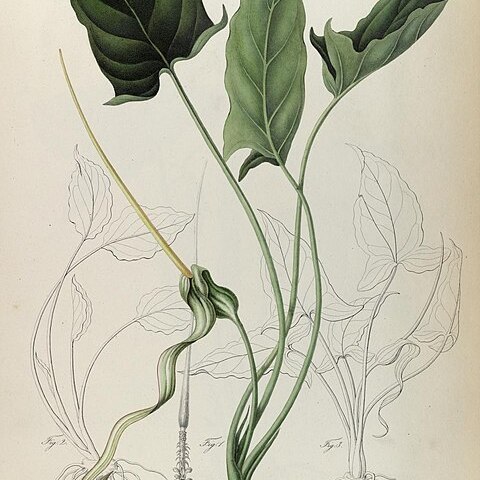Underground part a short, tuberous rhizome, depressed, 1-2 cm. Petiole green, 15-30 cm; leaf blade 5-25 × 0.5-18 cm, extremely variable, linear, lanceolate, elliptic, or hastate. Inflorescence appearing alongside leaves; peduncle 5-20 cm, thin. Spathe convolute at base, green, ovoid, globose, or depressed, 1.5-3.5 × 1.2-2 cm, constricted at apex, outside with 1 or a few keels; limb convolute-tubular at base, expanded and sharply flexed horizontally at apex, green on both sides or base flushed purple, lanceolate, 7.5-25 cm, tapering to long acuminate apex. Spadix shorter than, as long as, or slightly longer than spathe; female zone subcylindric, slightly fusiform, 1.5-1.8 cm × 8-10 mm; ovary pale green, elongate, angulate; sterile zone 1-2 cm, entirely covered with staminodes, these distant; staminodes dimorphic; proximal ones ca. 6 mm, with a horizontal white base, apically sharply upcurved, spatulate-lingulate and with or without a purple apex; distal ones downcurved, white, subulate, aristate; male zone ca. 5 mm; appendix subsessile, 16-17 cm, base swollen and often deeply grooved, apically filiform, erect, horizontal, or downcurved. Berries pale greenish, 2-or 3-seeded. Fl. Apr-May.
More
Rhizome cormous, stoloniferous, c. 2 cm diam. Leaves several together, appearing before inflorescence; petiole c. 10–30 cm long; blade elliptic to ovate, c. 6–25 cm long, with base acute to auriculate to cordate to hastate, pale to mid green. Inflorescence with short peduncle, rarely lifting inflorescence away from leaf bases; spathe base longitudinally keeled, to c. 3.5 cm long, greenish white to pinkish; limb narrowly lanceolate, sometimes long-acuminate, 10–25 cm long, proximally spreading, distally recurved or coiled, purplish brown to white inside, greenish outside; spadix equalling spathe; female zone c. 5 mm long, sterile interstice c. 2 cm long, bearing spreading distant black-or purple-tipped neuter organs c. 6 mm long in lower 1/2, ±narrowly pyramidal to filiform neuter organs c. 3 mm long in upper 1/2; male zone c. 5 mm long; anthers yellow with beaked connective; appendix subsessile, to c. 20 cm long, usually tapering from base, rarely stouter about 1/3 along its length, deeply ridged and channelled, yellowish green. Infructescence within persistent spathe base, ?at first.


